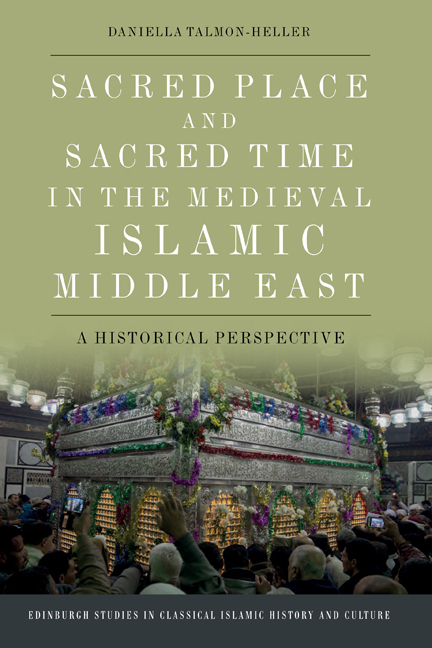Book contents
- Frontmatter
- Contents
- List of Figures
- Acknowledgements
- Map of the Middle East
- Introduction
- 1 Etic Concepts and Emic Terms
- 2 The State of the Art
- Part One A Sacred Place: The Shrine of al-Husayn’s Head
- Part Two A Sacred Time: The Month of Rajab
- Final Comments: Spacial and Temporal Sanctity
- Works Cited
- Index
7 - Excursus: Medieval Pilgrimage – Victor Turner’s Input
Published online by Cambridge University Press: 17 October 2020
- Frontmatter
- Contents
- List of Figures
- Acknowledgements
- Map of the Middle East
- Introduction
- 1 Etic Concepts and Emic Terms
- 2 The State of the Art
- Part One A Sacred Place: The Shrine of al-Husayn’s Head
- Part Two A Sacred Time: The Month of Rajab
- Final Comments: Spacial and Temporal Sanctity
- Works Cited
- Index
Summary
Probably best known for introducing the term communitas to the scholarship on pilgrimage and rites of passage, Victor Turner has made other valuable contributions to the research of sacred space. Although the paucity of source material on most medieval Muslim sites prevents us from fully applying Turner's insights to the subject at hand, his thought-provoking work at the very least promises to expose these limitations and still present constructive questions.
While conducting fieldwork in Mexico, in a region with many Catholic shrines and annual celebrations, Turner found it useful to expand his research horizons beyond any single place to networks of holy sites and to engage with the topography of rituals practised therein. He went on to map out the ‘catchment area’ from which pilgrims of each shrine were drawn and the attendant liturgical calendar, according to which they arrived at the various sites. In addition, Turner determined the spread, as well as overlap, of religious celebrations throughout the region. This research not only produced maps and diagrams, but also an imaginative analysis of the nexus between the local, regional and national; between nearby and far-off destinations; and between centre and periphery. Some of the most important destinations of pilgrimage, Turner concludes, are geographically peripheral. In other words, pilgrims do not necessarily flock to the ‘centre’, which Mircae Eliade has dubbed the axis mundi. And while shrines at the centre represent the authority of the dominant religious system, the peripheral shrine – whether more accessible for local pilgrims, or to the contrary, demanding the risky crossing of a stretch of wilderness – is often imbued with more power and ‘magnetism’.
As aluded to earlier, there are no extant sources that may indicate Mashhad Raʾs al-Husayn's catchment area in the first decades following its establishment. Therefore, we are unable to determine whether the new building served primarily as Friday mosque for Ascalon's residents, or as a monument that attracted visitors from outside the city. And if so, whether those visitors arrived from the rural hinterland of Ascalon, the further towns of Gaza and Ramla, or perhaps the even more distant Jerusalem and Cairo.
- Type
- Chapter
- Information
- Sacred Place and Sacred Time in the Medieval Islamic Middle EastA Historical Perspective, pp. 70 - 72Publisher: Edinburgh University PressPrint publication year: 2020



